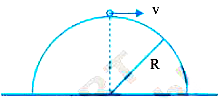A small metal washer is placed on the top of a hemisphere of radius R. What minimum horizontal velocity should be imparted to the washer to detach it from the hemisphere at the initial point of motion? (See figure) (AS1,AS7)

v=√(gR)
Topper's Solved these Questions
- BOOK - NCERT TELUGUCHAPTER - GRAVITATIONEXERCISE - Let us Improve our learning (Application of concepts)14videos
GRAVITATION
- BOOK - NCERT TELUGUCHAPTER - FLOATING BODIES EXERCISE - LET US IMPROVE OUR LEARING (Application of concepts)3videos
FLOATING BODIES
- BOOK - NCERT TELUGUCHAPTER - LAW OF MOTION EXERCISE - LET US IMPROVE OUR LEARNING (HIGHER ORDER THINKING QUESTIONS )3videos
LAW OF MOTION
Similar Questions
A small body of mass m slides without friction from the top of a hemisphere of radius r. At what hight will the body be detached from the surface of hemisphere?
 View Solution
View SolutionA small body of mass m slides without friction from the top of a hemisphere of radius r. At what hight will the body be detached from the centre of hemisphere?
 View Solution
View Solution
Knowledge Check
- Question 1 - Select One
A body rest on the top of a hemisphere of radius R. What will be the least horizontal velocity imparted to it , if it has to leave the hemisphere without sliding down?
A√2gRB√5gRC√gRD√3gR - Question 2 - Select One
A small disc is on the top of a hemisphere of radius R. What is the smallest horizontal velocity v that should fbe given to the disc for it to leave the hemisphere and not slide down it?[There is no friction]
Av=√2gRBv=√gRCv=gRDv=√g2R - Question 3 - Select One
A partcle rests on the top of a hemisphere of radiu R. Find the smallest horizontal velocity that must be imparted to the particle if it is to leave the hemisphere without sliding down it-
A√gRB√2gRC√3gRD√5gR
A particle slides down from the top outside smooth surface of a fixed sphere of radius a=10m . The initial horizontal velocity to be imparted to the particle at the top is 5Km/s ,if it leaves the surface at a point whose vertical height above the centre of sphere is 3a/4. Find the value of K
View SolutionA small ball is placed at the top of a smooth hemispherical wedge of radius R. If the wedge is accelerated with an acceleration a, find the velocity of the ball relative to wedge as a function of θ.
 View Solution
View SolutionA partcle rests on the top of a hemisphere of radius R. Find the smallest horizontal velocity that must be imparted to the particle if it is to leave the hemisphere without sliding down :
View SolutionA particle rests on the top of a hemishpere of radius R. Find the smallest horizontal velocity that must be imparted to the particle if it is yo leave the hemisphere without sliding down it.
View SolutionA small ball is placed at the top of a smooth hemispherical wedge of radius R. If the wedge is accelerated with an acceleration a, find the velocity of the ball relative to wedge as a function of θ.
 View Solution
View Solution
